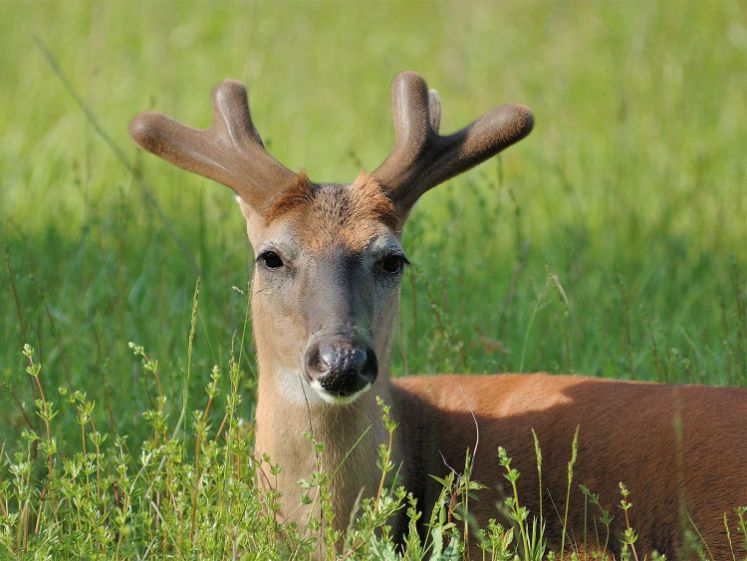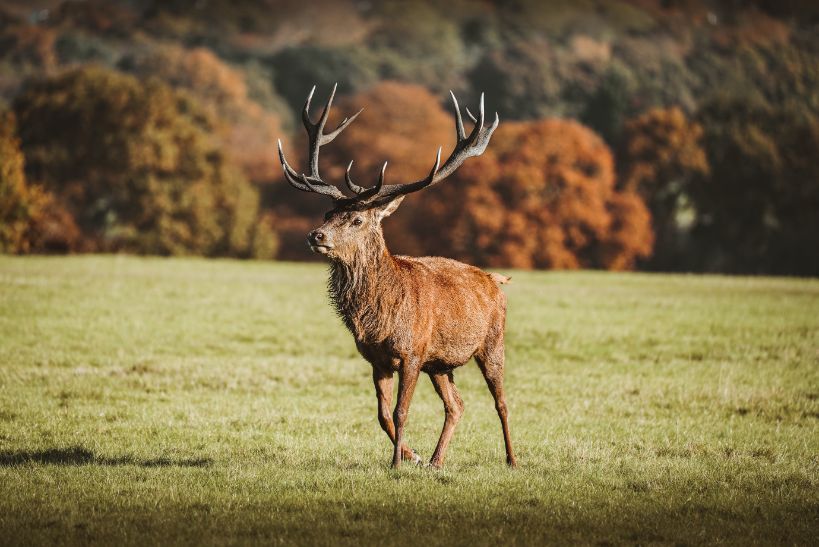Since people used to hunt deer for their antlers, skin, and meat, the activity has long been very well-liked. Numerous tribes continue to hunt deer for food in many parts of the world.
Have you ever wondered if female deer have antlers? Perhaps you’ve noticed that female deer don’t have antlers in the local species you’ve observed or learned about, but what about the numerous other deer species found throughout the world? Do female deer have antlers elsewhere on their bodies? Please keep reading to find out the answers.
Do Female Deer Have Antlers? Why?
Antlers can develop on both male and female caribou (reindeer). Generally speaking, only male deer of other species of deer develop antlers. There are, however, a few unusual cases in which females will also develop antlers. This typically happens when the female deer has a hormonal imbalance (high testosterone levels).
In reality, female deer with antlers are hermaphrodites or pseudohermaphrodites. Due to a genetic anomaly, hermaphrodites have both male and female sex organs. Pseudohermaphrodites have mismatched external genitalia despite having matched chromosomes and tissue in their ovary or testicles.
Deer that are hermaphrodites, such as does with antlers, males with reproductive abnormalities, or even part female.
Just wait until you learn about pseudohermaphroditism if you think that’s confusing. Deer exhibit male and female forms of pseudohermaphroditism. A deer with female pseudohermaphroditism has testicles and ovaries. Antlers and the external genitalia of a female deer are found in deer with male pseudohermaphroditism.
The Journal of Wildlife Diseases reported on a case of a male pseudohermaphrodite. “The male pseudohermaphrodite white-tailed deer (Odocoileus Virginianus) is described. The animal, which was killed in Aiken County, South Carolina, on November 4, 1971, was 1.5 years old and resembled an antlered doe from the outside.”
Further Reading:
- How Fast Can A Deer Run?
- Do Deer Eat Hay?
- Deer Gestation Period: How Long Do Deer Pregnant?
- Do Deer Move In The Rain?
The Antler Cycle Of Female Reindeer
Antler size differs significantly between male and female reindeer, with females having much smaller antlers. While a female is more likely to develop antlers that are 20 inches long, a male can grow antlers that are up to 50 inches long after several seasons of shedding. However, the durations for which the two keep their antlers can also be used to distinguish between them.
Just after giving birth to their calves in May, females lose their antlers, but later that month they start to regrow them. That ensures that their antlers are at their fullest during the vulnerable months of pregnancy, leaving a very small window during which female reindeer are devoid of antlers.

Although female reindeer herds compete fiercely for resources, they are fiercely protective of their members, especially they are young. Mother reindeer must rely on their own wits to survive in the wild and make sure that their pregnancy is healthy because males rarely stick around to assist with the raising of fawns.
There is no need for female competition in ecosystems where there is an abundance of food for deer. Reindeer, however, is an exception.
The habitat that female caribou live in—cold tundra with a noticeable lack of resources—is one compelling theory for why they evolved to grow antlers. Females’ aggressive characteristics evolved as a result of increased food competition. That appears to be reflected in the reindeer herds’ social structure. It’s one where females with bigger antlers benefit from higher social standing and easier access to food.
Due in part to the purpose that antlers serve for reindeer, this is true. The enormous size of a reindeer antler’s horns makes them excellent defensive weapons, but these antlers can also be an essential scavenging tool in the wild. In the frozen tundra, antlers are used to define territory and dig potential food sources.
Caribou mothers are frequently left to care for themselves without male care once the rutting is finished and the worst effects of winter have set in. They also use these amazing bone tools to carve out their own food during the toughest months of the year.
Why Do Deer Grow Antlers?
Attract A Mate
In order to seduce a female deer for mating, male deer grow antlers. Females will be shown a display while the antlers are growing during mating season, with each male competing to become the most dominant.
Males fight one another with their antlers. In order to assert their dominance and battle for a female mate, they will also use their antlers as weapons. In order to demonstrate their dominance, they also rub their antlers against trees. Due to their competitive nature, males with the largest antlers are more likely to have successful fertilization and to attract females.
Unknown factors include male-to-male fighting, the outcome of the display, or the size and shape of the antlers, which vary among species.
Defense
Deer can defend themselves against predators and other deer with the help of their antlers. The deer may starve to death as a result of the antlers locking together occasionally when fighting other deer.
Finding Food
Deer are herbivores and only eat fruits, nuts, and acorns. They do not consume meat. You can use the antlers to topple fruit from trees. When the time is right, they also use their antlers to break acorns and nuts.
Relaxation
Deer use their antlers in a variety of ways to cool off and relax in the summer when it gets hot. Deer can lie down, relax, and keep insects away by making depressions in the mud or dirt with their antlers.
How Are A Deer’s Antlers Grown?
A deer’s antlers are actually made of bone. The spring is when they begin to grow, and the summer is when they finish. By fall, the antlers have grown to their full size. The velvet covering the antlers will be shed by the deer once they have reached full maturity. This process is known as “antler shedding.” The antlers are smooth and hard after the velvet is shed.
What Kinds Of Deer Have Antlers?
All North American deer are antlered. Native to North America, deer come in two species. The mule and whitetail deer are these. The Pacific coastal blacktail subspecies of mule deer is another subspecies that can grow antlers.
Elk, caribou, and moose all have antlers, with moose having the largest antlers. Antlers begin to develop at one year of age.
The Impact Of Nutrition On The Growth Of Antlers In Deer
Throughout different stages of their lives and the antler development process, stags are susceptible to the negative effects of nutrition. Deer develop massive antlers. Feeding during the prenatal, postnatal, and yearling periods affects spike antler length, and there is a close correlation between antler length and body weight. The growth of reindeer antlers can take up to five years in stags.
Antler length is largely influenced by body size and fitness at casting, not diet, during the juvenile antler development stage. at the start of new antler development. Adult stags’ antler growth is only slightly influenced by diet protein levels of over 7%. Antler development may be boosted by adding supplements of food containing methionine or fortified proteins, which is a useful item for them.
Calcium is taken from the skeleton to maintain the significant amounts of calcium and phosphorus that are retained as polished antlers mineralize.
Finding the times when young stags are most at risk of malnutrition and providing enough calories to help adult stags regain the proper body composition between the end of the mating season and antler castings are both important components of feeding plans for excellent antler growth. Normally, this takes place from October to December.

